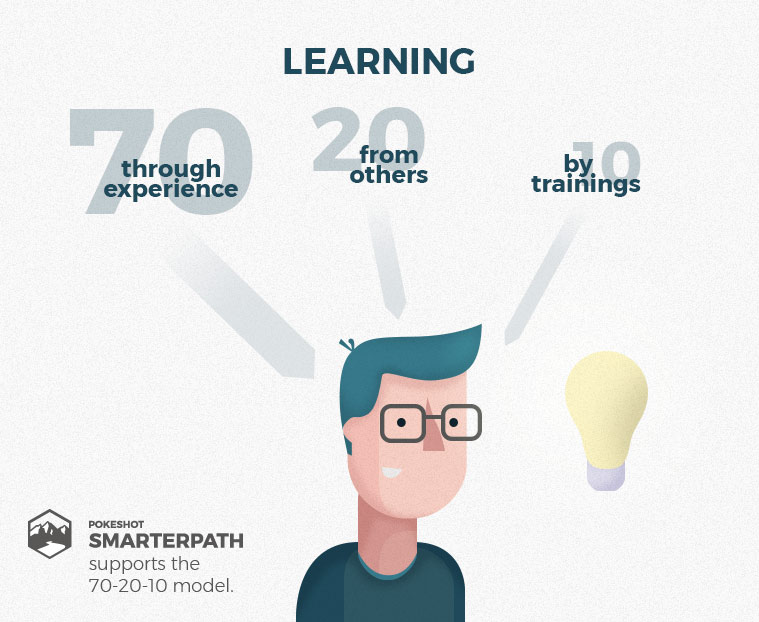I guess the one advantage of having no WiFi on the long train journey from Dresden to Berlin (thank you, Deutsche Bahn) is that it gives you plenty of time to think.
I first explained this model in a blog entry that I wrote some two years ago on the way back from Learntec. At that time, it was virtually an unknown concept. Fortunately, however, attitudes towards learning in the workplace have changed. I have recently been hearing more and more of this model being brought into the learning environment, and the first customers have already asked us for assistance. So I think it’s time to delve a little deeper into the topic: What is the 70:20:10 model and how can SmarterPath help me to implement it?

The 10% – learning through structured, formal training programs
Creating an intelligent learning path in SmarterPath is simple, and allows you to incorporate all possible types of learning content: documents, videos, quizzes, SCORMS, etc. Linked together, this content forms a “smarter path” that can be used for in-house training purposes in areas such as quality assurance, compliance, or fire safety. You can also integrate blended learning elements such as live trainings (ILTs).
So what sets it apart from other applications? SmarterPath isn’t the sort of app that floats around outside the employees’ familiar working environment. It is fully integrated into popular enterprise social networks such as Microsoft Office 365 and Jive, so that users searching for information find a pre-prepared collection (keyword: content upcycling) of information and knowledge compiled into a compact smarter path. It is precisely this integration that sets SmarterPath apart and allows it to support both the 20% and the 70% of the learning model.
The 20% – learning through others
To be able to learn from others, employees must first know that these people exist. This involves establishing a network of experts. To help achieve this, SmarterPath also allows intelligent pathways to be assigned to people and places: “This is your trainer,” “This is a place you can exchange ideas with your team,” “This is your supervisor,” “This is the expert on topic X,” etc.
- SmarterPath enables discussions and collaborations on content and topics that employees can continue and develop further even after the training session itself has ended. The opportunity to share ideas about the pathways enables employees to gain new input from other perspectives.
Have you thought about user-generated content (UGC)? My colleague Linda Werner recently wrote a very interesting blog article on this topic. She explains that the creation of UGC is not confined to specific departments. Thanks to the simple usability of SmarterPath (select the content, create an intelligent pathway), every employee can, in principle, create content. Each and every member of staff is capable of building smarter paths and sharing these paths with their colleagues. Learning through others – it’s as simple as that!
The 70 % – learning through experience
SmarterPath provides everyone in the community with the opportunity to learn from first-hand experience. Its intelligent learning pathways can be integrated wherever there is a need for information – links can be inserted into documents, blog entries, and group discussions, and discussions can be created on each individual pathway. The paths can also feature various calls-to action (CTAs), ranging from live training sessions to “Complete this” or “Do that” tasks. Embedded in the community itself, SmarterPath accompanies the learner from the initial information through to the independent implementation of training activities. Most people find the distinction between the 70%, 20%, and 10% a fluid one, as in principle learning from others also involves personal experience.
SmarterPath is particularly good when it comes to presenting new employees with training scenarios (onboarding) – whether they are new to a particular tool (e.g. Microsoft Office 365) or have just joined the company and would require a great deal of time and resources to be trained up if it weren’t for SmarterPath. With these first intelligent learning pathways, you acquire all the knowledge you need, find the right contact partner, exchange ideas, and gain your first experiences – this is the SmarterPath solution!
SUMMARY
But don’t forget that SmarterPath alone is not enough! A use case such as this should be well thought through. An independent onboarding community can help in this regard, as can involving training instructors as moderators of this group. Otherwise, the only advice I can give you is: give it a go! Your employees’ knowledge is right there in their minds. Create your own intelligent pathways or take the content created by your employees and compile this into smarter paths (content upcycling). Learning has no limits, and neither does SmarterPath.
 About the author:
About the author:
Sandra Brückner, who studied business informatics at the Technical University of Dresden, has worked as social business consultant since 2012. She joined the Berlin-based social business consultancy and technology provider Pokeshot in the beginning of 2014 and has served for more than two years as Chief Product Officer for all products.
Connect with us on facebook | twitter | LinkedIn | YouTube – we will keep you posted!

2 thoughts on “What is the 70:20:10 model and how can SmarterPath help me to implement it?”